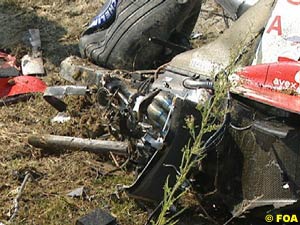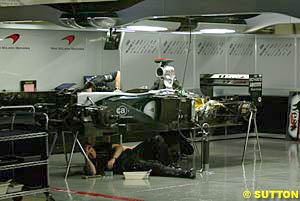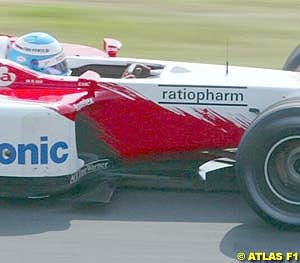
Atlas F1 Technical Writer
The Suzuka circuit is always challenging for all the Grand Prix teams, and this year was not different. Craig Scarborough reviews the cars as well as the teams in the final race of the 2002 season
Every driver complained of the track being dusty and low in grip, due to the dry weather and the recent track work. These changes affected the racing line and run offs around the "Esses" but actually resulted - along with other variables - in faster lap times: pole position was more than a second faster than last year's time.
The track and air temperatures were high most of the weekend and with no great variation between sessions, adding to the genuine parity across the field. The flip side of the warmth was the effect on reliability: there was a high attrition rate in the race, with major engine failures and some gearbox problems. Furthermore, there was an inordinate amount of electronic failures, forcing several cars into the pits, and eventually out of the race.
New engine specifications were run in Japan: Honda's previous qualifying engine was promoted to race engine and a new spec version debuted for Qualifying, although this "Suzuka special" was only a moderate upgrade over previous versions. Jaguar had a new spec Cosworth engine and the last narrow angle version to be run by Jaguar in the races.
While the manufacturers boasted engine development, electronic updates were more covert and included new ECU hardware as well as software revisions. The number of electrical issues prompted suggestions that 2003 spec electronics were run in preparation for next year.
Another less visible development were revised suspension parts which three teams brought to Japan. Williams and McLaren had new rear geometries and BAR were being cagey about a new development found by Ferrari for Bridgestone that optimised and preserved the tyres. These "development" parts were tried in testing and only enough parts for Jacques Villeneuve were available, leaving the outgoing Olivier Panis without the benefit from the tyres. These parts were understood to be suspension parts with revised geometry.
Aerodynamic updates were sparse - only Toyota deciding to run the new bargeboard/floor set-up in preference to the older versions. While the new aero parts were tested at Toyota, so too were the car's safety features. A potentially dangerous accident befell Allan McNish, which in turn echoed a number of other accidents from Friday.
While the electronics do a fine job controlling this, if the car enters the corner too fast, traction control will help recover the car somewhat, but this takes space and when the exit kerbs come up and unsettle the car, no electronics will recover the situation. Classical driver reactions and opposite lock can save the day, but as happened with three drivers this weekend the cars still ran out of space and had an impact with the barriers. Villeneuve and Juan Pablo Montoya's Friday incidents were mild in comparison to the incident that befell McNish mid way through Qualifying.
McNish oversteered into 130R, over-corrected, and the car reacted by spinning back on itself. As the car travelled backwards momentarily, the wings and kerbs lifted the car airborne. The car hit the barrier square on from behind and ripped through the three pieces of guardrail. The car then hit the grassy bank and finally spun through another 180 degrees before coming to rest.
Damage to the car was extensive, but there was no major intrusion into the safety cell or failure of safety components other than the barriers, which helped dissipate the energy of the crash. Subsequently, McNish was able to step out of the car bruised but otherwise unhurt. He underwent medical examination and was passed fit to take part in Sunday's warm up, when his knee became inflamed after the 30-minute session and under advice from FIA medical officer Sid Watkins, the Scot withdrew from the race.
Team by Team
Ferrari
Friday morning saw Michael Schumacher quickest and the only concerns were for damage to his tyres after driving past Villeneuve's accident debris. Rubens Barrichello was second and had a small spin. After clear running in Friday's morning session, Schumacher had a rare technical problem with his hydraulics and had to sit out most of the session, leaving Barrichello to complete the tyre evaluation programme.
Both drivers extolled on the virtues of the F2002's handling - Schumacher was having great fun throwing the car through the esses and in qualifying sacrificed a set of tyres to go for another run and an even faster lap.
For the Race, the Ferraris made great starts and Schumacher had the edge - the German opening a gap of more than two seconds in the first lap. Barrichello at the same time had problems with the car grounding its plank on the heavy fuel load and lost even more ground. But for the balance of the race, the F2002 ran smoothly as ever to post another one-two finish for the World Champions.
Williams
The FW23 was updated with new suspension geometry evaluated and recommended by the test drivers in tests before the race.
Friday brought spins for both drivers in the Degna curve - Ralf Schumacher escaped damage in his, while Montoya was running over the kerbs losing his bargeboards in the process, before a sizable impact with the barrier. "It was a big impact and I feel a bit shaken," he said afterwards. Despite lost time, both drivers were happy with the balance of the car, although Montoya stated that "there's still room for improvement."
Throughout qualifying, both drivers were not happy with the handling, suffering understeer from the front and oversteer from the rear. It was therefore decided overnight to try the old rear suspension, and after some tuning in the warm up session it was declared much better than the new version so the team decided to keep it for the race.
Both Williams made a good start and split the McLarens, after which they maintained the gaps. But with five laps to go, Ralf Schumacher retired from third position with a major engine failure, while Montoya initially had some oversteer. He made front wing changes at his first pitstop and was able to run cleanly to the end of the race.
McLaren
Perhaps not surprisingly, considering the new gearbox, there were hydraulic problems for David Coulthard on Friday. Nevertheless, the revised car was working well on the Michelin tyres and challenging Williams.
It was the potential for engine problems that interrupted Kimi Raikkonen's qualifying session: a suspected pneumatic valve problem was picked up on the telemetry and his spare was readied. Again, though, the car went better than the Williams and put the team in good stead for the race.
Overall equal on pace and splitting the Williams, both drivers suffered from fly-by-wire throttle problems during the race. Coulthard departed early with a crawl back to retire in the pits, and Raikkonen had a clean race until similar problems lead him to ease off in the closing laps to nevertheless post a rare finish.
Renault
Japan offered a clean, if not rewarding race weekend for Renault. Friday's work concentrated on evaluating tyres for the race and refining the set-up. Both drivers had pace in the interrupted qualifying session, but keeping back tyres for the race limited their last runs.
Running an early-stopping, two-stop strategy in the race - party to leapfrog the Jordans - worked well, with Jarno Trulli pulling off to retire after an unnamed "mechanical problem" following his second stop, and Jenson Button posting a third consecutive finish and points-score for the team.
Sauber
Friday was beset by problems, with Felipe Massa back in the car, he struggled with a spark plug problem and Nick Heidfeld had handling troubles on new and old tyres. "On old tyres I had oversteer, whereas new ones gave me understeer," he said.
Tyres caused trouble in qualifying too, with graining mid way through the flying lap. In the race, Mass retired as he went off at Degna, having got a little wide, and Heidfeld got the car handling better in the first two stints but struggled in the last.
Jordan
The car was a bit nervous through the esses but still was responding well on the Bridgestone tyres. In qualifying, Giancarlo Fisichella had gear selection issues, stating that "the automatic downshift went completely mad!" Takuma Sato had an engine blow up in the morning, which meant that for qualifying he had to run on the older spec Honda engine. Nevertheless, the Japanese posted his best qualifying position of the year, stating that "the car was good, I was comfortable and drove exactly as I wanted to. I just nailed it!"
With a strong grid position, Sato's race was endangered with understeer, leaving him vulnerable the Renaults. At his second stop the team gave him more front wing angle and "transformed" the car to deliver a convincing points finish.
Fisichella's race-day had started badly with a spin in the warm up session, followed by a formation lap engine failure and eventually another engine failure, which forced him out of the race.
BAR
With the qualifying engine from Indianapolis as the race engine this weekend, the team had a revised qualifying engine to replace it. Jacques Villeneuve's big shunt on Friday limited the tyre testing necessary, forcing Olivier Panis to complete more laps than planned.
Panis then had gearbox problems, but the interrupted session allowed repairs on his car and gave him an opportunity to post times in his race car. However, the problems returned and he was forced into the spare car again.
During the race, Panis retired early on while Villeneuve's engine let go after 27 laps.
Jaguar
Eddie Irvine and Pedro de la Rosa suffered from lack of rear grip during Friday, while Irvine also complained about braking problems. On Saturday, the new Cosworth qualifying engine frustratingly seized in both the morning and qualifying sessions. And in the race, Irvine made it to the finish while de la Rosa pulled off to retire with a sudden transmission problem.
Toyota
Both drivers went well on the Michelin tyres on Friday. In qualifying, Allan McNish had already set the 18th fastest time before his big accident, and Mika Salo was disappointed not to make better use of the pace in the car when the session resumed.
Running solo for Toyota in the race, Salo fought on with tyre problems and a sensor failure, which was cured by the bi-directional telemetry.
Minardi
Drama in the pit garage on Friday was caused by a small fire around the gearbox and resulted in extinguisher dust spread all over the pit garage. Mark Webber commented that Friday was otherwise "pretty good for us" and Alex Yoong would use Webber's data to choose which tyre spec to run.
Webber lost time on Saturday morning with broken gearbox shaft and splitting their Michelin tyre choice, the drivers qualified only three tenths of a second apart. Running the softer tyre and lower fuel load, Yoong got by Webber at the start of the race, but the car was without power steering and the Malaysian failed to control a tail slide and went off, while Webber fought low grip to finish tenth.
The technically challenging figure-of-eight track in Suzuka played host to the last and most evenly matched race of the year. While the result quite accurately reflected the relative pace of the cars, similar performances from both tyre companies and a common two-stop fuel load allowed spectators to see the cars on the flattest of playing fields.
 Several cars had damaging spins at Degna, Spoon and 130R; the latter in particular is a corner taken at 185mph, and a problem or error is heavily punished at this speed. Even with driver aids like traction control the cars still walk on a tight rope between grip and losing control. One of the effects of traction control is to control power oversteer, which is when the car exits the corner and full throttle is applied. The electronics work out if the rear of cars slides too much, limiting power to return the car to a more normal attitude.
Several cars had damaging spins at Degna, Spoon and 130R; the latter in particular is a corner taken at 185mph, and a problem or error is heavily punished at this speed. Even with driver aids like traction control the cars still walk on a tight rope between grip and losing control. One of the effects of traction control is to control power oversteer, which is when the car exits the corner and full throttle is applied. The electronics work out if the rear of cars slides too much, limiting power to return the car to a more normal attitude.
 As McLaren aim to run this year's car in the opening races of next year, and as ballast has already been placed as far forward as possible to tune the car to its Michelin tyres, McLaren have finally raced their much tested new rear end. Designed to be lighter and to move the weight forward, the new set-up uses a new gearbox casting, suspension and uprights. The new uprights relocate the brake calipers to a forward vertical position rather than a low horizontal placing. Otherwise, the new arrangement appears the same as the older version, with the dampers being mounted partly enclosed in a recess in the gearbox casting and operated mid way up by the bell cranks.
As McLaren aim to run this year's car in the opening races of next year, and as ballast has already been placed as far forward as possible to tune the car to its Michelin tyres, McLaren have finally raced their much tested new rear end. Designed to be lighter and to move the weight forward, the new set-up uses a new gearbox casting, suspension and uprights. The new uprights relocate the brake calipers to a forward vertical position rather than a low horizontal placing. Otherwise, the new arrangement appears the same as the older version, with the dampers being mounted partly enclosed in a recess in the gearbox casting and operated mid way up by the bell cranks.
 The new bargeboards and floor were easier to see this weekend, as the bodywork was run most of the time. More Jordan-like in design, the forward-placed bargeboards consist of two panels, a lower, larger forward board, and are mounted higher. There is a smaller board on the inside as well, and both are placed well towards the middle of the car and are notched to clear the lower suspension.
The new bargeboards and floor were easier to see this weekend, as the bodywork was run most of the time. More Jordan-like in design, the forward-placed bargeboards consist of two panels, a lower, larger forward board, and are mounted higher. There is a smaller board on the inside as well, and both are placed well towards the middle of the car and are notched to clear the lower suspension.
Please Contact Us for permission to republish this or any other material from Atlas F1.
|
Volume 8, Issue 42
Atlas F1 Exclusive
Exclusive Interview with Rory Byrne
Ann Bradshaw: View from the Paddock
Japanese GP Review
2002 Japanese GP Review
Japanese GP Technical Review
Bridgestone: The Shining Quarter
The Human Touch
Stats Center
Qualifying Differentials
SuperStats
Charts Center
Columns
Season Strokes
Elsewhere in Racing
The Grapevine
> Homepage |